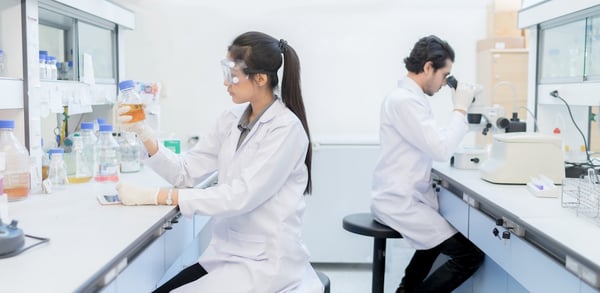
Water quality testing equipment is a staple in environmental, life science, and medical research laboratories. In the environmental sector, compiling data on stormwater, groundwater, surface water, and soil is often a vital part of daily operations. In the life science and medical fields, water testing equipment is used to research a variety of solvents and solutions besides water alone.
The exact model of water testing equipment that’s used in a laboratory depends on the nature of the research and the goals of the researcher. That said, most labs rely on benchtop meters and may use portable meters in addition. Below, we’ve outlined the unique uses, features, benefits, and pitfalls of each tool.
Portable Meters
Portable meters are popular in the environmental sector because they’re compact and perfect for field research. In order to collect water or soil samples from a variety of locations, researchers need a tool that’s easy to grip and read, regardless of the location or environmental conditions. Portable testers that have a backlit display screen and are easy to operate in one hand are ideal for field use. In such instances, the durability, memory, and battery life of the water tester are exceptionally important, as well. The best portable meters are dust- and water-resistant and have enough memory to store all the test data that’s compiled during a research trip.
All water testing equipment must be calibrated to ensure accurate results. Because portable meters have a smaller interface than benchtop or in-line meters, they naturally need to do more with less. With just a few buttons, users must be able to calibrate their tester, take new readings, browse archived data, and store new test results. In this regard, bluetooth-powered water quality testers that connect to smartphone apps offer a much more agile, custom, and sophisticated user interface.
Some pH and temperature testers have built-in electrodes; others require the user to attach an electrode to the meter via a wire cable. For soil or non-aqueous (not water-based) testing, separate, application-specific electrodes typically provide more accurate readings because they’re designed to take readings under unique conditions. Meters with built-in electrodes are generally more efficient and require less manual finagling in the field. The model you choose depends on the substance you’re testing and the level of sophistication you’re looking for.
In addition to field testing, portable meters are used in labs for convenience purposes. Whereas benchtop meters are built to reside on a flat surface, portable meters are easy to move around within a facility and don’t take up valuable workspace.
Benchtop Meters
For most laboratories, benchtop meters are a must-have. For starters, they’re slightly larger than portable meters and provide a bigger display screen to view test results. They also tend to offer greater sensitivity ranges than their portable counterparts. Like portable testers, benchtop meters may be specialized for a specific function, such as pH or conductivity, or they may offer a variety of testing functions from a single meter interface.
When choosing between different benchtop meters, researchers usually look for the specific functionality and testing range they need for their research. In addition, the accuracy and resolution of the measurement that the meter provides may be more important to some researchers than others. For example, chemists may opt for a meter that provides 0.001 resolution (extremely precise), while other users may be satisfied with a lower resolution.
Electrodes
An electrode is the conductor of the electrical current that’s used to test the properties of a substance. Electrodes must connect to a circuit—in this case, a meter—via a wire and relay information back to this source.
Like meters, electrodes can be designed to perform a single function or built for a variety of different tests. They’re typically made of glass or epoxy and can vary in size, response time, measurement range, and pressure tolerance. Epoxy electrodes are made to be more resistant to impact, but can’t be used in high temperature solutions. In contrast, glass electrodes are more fragile, but better suited to extreme temperatures and unclean environments due to the fact that glass is easy to sterilize.
The type of electrode used in a lab depends on both the functional needs of the researcher and the type of meter that they’re using. For instance, if you need to test an oxidation reduction potential (ORP) range from -1,000 to 1,000 mV, both the electrode and the meter should be sensitive to this range.
Additionally, electrodes can be refillable or non-refillable. Both refillable and non-refillable electrodes naturally leak electrolyte fluid through the porous junction, but refillable electrodes can be replenished on a routine basis. Although they require more maintenance, they tend to have longer useful lifespans than non-refillable models. As long as the junction remain unclogged and uncontaminated (by protein, food, or soil, for instance) users can refill the reference electrode. In contrast, non-refillable models are typically cheaper and may use a gel-based electrolyte solution that leaks out of the electrode at a slower rate. Still, there still a risk of this solution becoming contaminated through the junction with use. Testers that have built-in electrodes are almost exclusively gel-filled.
Before purchasing water quality testing equipment, evaluate the unique benefits and functions of different models within the context of your research environment and goals. To get started, learn about Jenco’s many portable meters, desktop meters, and electrodes by following the link below.

Comments